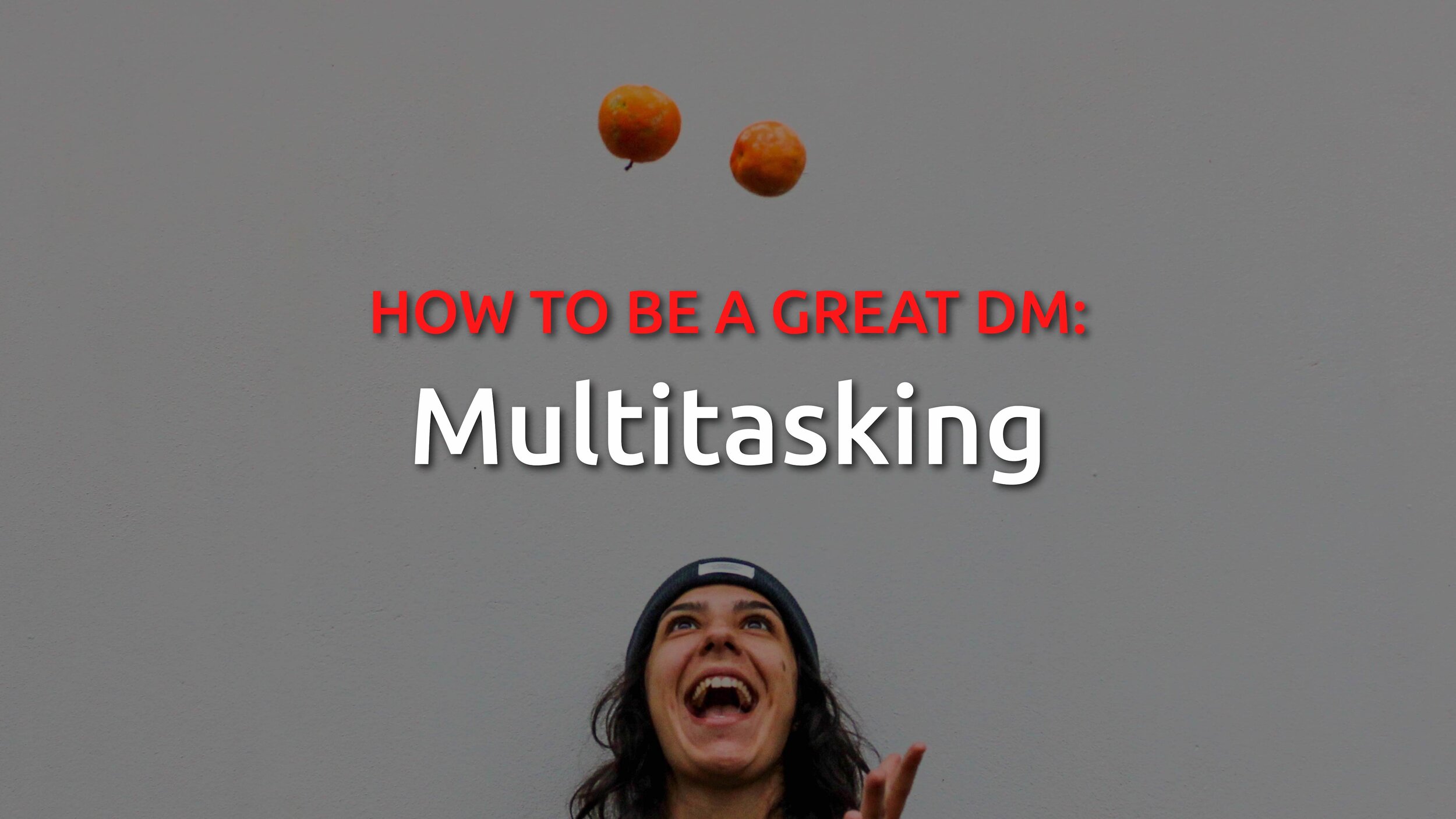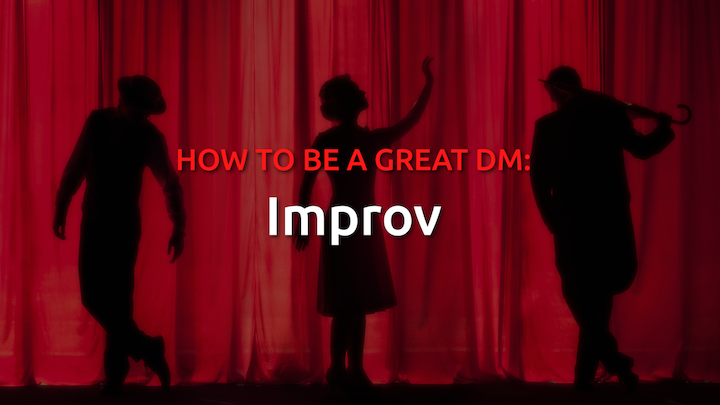Great DMing: Storytelling
Be a great DM
In my recent post, I talked about learning to play the game. That’s the first step to becoming a great DM. Just like an author must first learn to write, then she can break the rules of grammar when it suits the story.
Once you understand how to play DnD, you can start running your own game. This is where the storytelling comes in. There are entire careers dedicated to how to tell a good story. And if you want to join the ranks of DM greatness, you’ll have to dedicate yourself to mastering storytelling as well.
Think like a novelist
Here’s the only real difference between DMing and novel-writing: you do not have control of the main character’s choices.
Yeah, I know, that's a big deal. So let’s break down storytelling a bit more, first. Let’s starting thinking like a novelist.
Every story is made up of three parts – the beginning, middle and end. Yes, I realize that sounds like a very basic concept. Just like you need the proper bricks to build a brick house, so you need to fully appreciate the impact of a beginning, middle and end. There are authors who struggle with these three things. There are debates on the appropriate lengths and beats within these sections.
Irrelevant. Your stories will always need a beginning, middle and end to be powerful to their audience.
How do you determine if you have begun or ended a story? That leads us to the two most important elements of a story: the problem and the solution. Consider this – every enduring story you’ve ever heard has introduced a problem. Let’s walk through some notable examples:
The Lord of the Rings – there is a powerful ring that if not destroyed will bring about the end of all good in the land
Star Wars: A New Hope – the empire has built a terrifying new weapon in its quest to oppress the galaxy
Shrek – Shrek is told that unless he rescues a princess, his swamp will continue to be invaded by annoying fairy tale creatures/people
Harry Potter and the Chamber of Secrets – a powerful, dark chamber threatens the lives of Hogwarts’ staff, students and residents
Yessssss, stories that are full of problems! These problems are the beginning of the story. How your characters deal with the problem is the middle. And the end leads us to the second element: all stories have a solution.
Now, the solution doesn’t have to be good. It can be terrible. Tragedies are a type of story. You get to be the architect of this story, so you can build it into any genre you desire.
But all stories are have a problem and a solution. Let’s walk through the stories we just mentioned above (SPOILERS):
The Lord of the Rings – the fellowship sets out to destroy the ring, but only Frodo and Sam make it to Mount Doom to destroy the ring, and only at the great cost of Frodo’s emotional well-being and one of his fingers (not to mention a massive war fought against the race of men that kills thousands of people)
Star Wars: A New Hope – Luke blows up the Death Star through his fancy flying and relying on the Force, since he finds out that he is a Jedi, although he is not quick enough to save the lives of many rebels and their ships
Shrek – Shrek ends up ruining his chances for a happy hermitage by crashing the wedding of the guy who sent people into his swamp to begin with, but because his sidekick made friends with a dragon along the way the main antagonist gets eaten and Shrek gets a princess instead of a hermitage
Harry Potter and the Chamber of Secrets – Harry kills Tom Riddle’s diary, ending his evil plan to come back to life and continue killing students he dislikes, but not before Harry is bitten by a basilisk and almost dies (he is healed by phoenix tears)
Some of these solutions are completely straight forward. Like in LOTR, the ring was the problem and destroying it was the solution. Other stories the solution is unexpected – Shrek thought his problem was being bothered by people, but it turns out the solution to his problem was to make friends and fall in love, not avoid people.
Whether your solution is straight forward or a total surprise, every solution to a story should come with a cost. Sometimes the cost is small – Harry is healed of all his wounds in the Chamber of Secrets. Sometimes the cost is high – a lot of rebels die in the battle in A New Hope.
Here’s what a story should look like:
Beginning – Problem is introduced
Middle – Characters try to solve problem
End – Problem is solved (although not always how the characters expect, and there’s always a cost)
There you have it, that’s the structure of a novel. Or any other kind of story.
Embrace the prep
Writers get into fist fights over the best way to craft a novel. Some writers prefer to write out complex outlines and backstory before they even begin writing the main work. Other writers like to discover the story as they write, believing in the process and knowing that they can go back and rewrite any discrepancies.
Both methods and their variations are valid forms of writing.
However, when you are leading players through an RPG, you must anticipate all the possible ways they might choose to solve their problem.
Remember the real difference between DMing and novel-writing: you do not have control of the main character’s choices.
This means that to be a good storyteller for DnD, you need to put in the prep time.
Let’s use Star Wars: A New Hope as our guideline. You’ve just told your players that the Empire has designed a new weapon and Princess Leia has escaped with the plans. She smuggles those plans into a droid, who takes them to a nearby desert planet in search of someone called Obi Won Kenobi. She is then captured by the Empire.
The players know the big problem: the empire plans to use their new weapon to further oppress the galaxy.
Here are your players’ characters:
A Paladin named Luke – a young man with absolutely no skills or fashion sense, totally inexperienced as a Paladin
A Rogue named Han – a man with great survivor skills but has too many enemies and little moral caliber
A Barbarian named Chewbacca – a creature motivated by anger and savagery who is completely loyal to Han
A Cleric named Leia – a princess trained in diplomacy and warfare who is constantly underestimated because of her appearance (secretly has more skills, but they don’t come to light during this campaign)
What’s the first thing Luke might do after his new NPC droid runs away in the night?
What does Han do when he is offered a job of flying Luke and Obi Won to save the Princess?
What does the Princess do when she is face to face with Lord Vader?
What does Chewbacca decide to do when the group is being shot at in the corridor outside of Princess Leia’s cell?
Sure, you might remember the choices in the movie, but players won’t know the story like you know it. They haven’t seen the movie in your head. They might decide that it’s better for the group to rush the prison guards instead of blowing a hole in the wall and jumping down into the garbage chute. What are you going to do if they rush the guards? How are you going to help them reach their goal of thwarting the empire’s plans to oppress the galaxy?
Your story has to be malleable enough to allow for player decisions.
Maybe the players decide to rush the guards and an explosion throws them down into the garbage chute. Or maybe they overpower the guards, find Lord Vader and convince him through charisma to turn on the Emperor and blow up the Death Star himself. Maybe they decide to blow up Vader’s ship and fly off to celebrate their victory on a gambling planet instead of confronting the empire at all.
Craft a story with lots of possible small problems and one big problem, then allow the players to decide how to solve or avoid or die from those problems themselves.
Let the players decide how to reach the ending of your story.
You can best accomplish this kind of storytelling through lots and lots of prep.
Don’t be daunted
I know this can be very daunting at first. I was paralyzed when I first started. There were so many choices before me. To escape those choices, I did what anyone starting out would do – I copied someone else’s work. Specifically, I used a premade adventure path to help shape my first adventure.
A lot of people do not like using these as they want to feel they fully own their own adventure. That's legit. Nothing wrong with that. I, however, didn’t know what I was doing and didn’t want to have to come up with all the details of a new game by myself on top of learning how to run one.
One of the reasons I started Verge Games was to help people learn and grow as a DM.
Whether you choose to start your path to DM greatness by utilizing a ready-made one-shot adventure module (or a full campaign), or craft your first campaign yourself, remember this: we all started out not knowing what we were doing. You’re not the only one.
You’ll get there, just don’t be daunted.
Last thoughts
Good storytelling is hard. Most writers spend their careers, their lives, learning how to better tell a story and how to tell a better story. If you can master the journey of storytelling, you’ll be one step closer to DM greatness.
And never forget that every story has a beginning, middle and end, a problem and a solution. And if you want your players to enjoy your DMing, you have to write a story that can move and change around the players’ decisions.
Remember, all the organization in the world is helpful. But with a DnD campaign, chaos is likely.
#NumberOneJosiah
Jo is our co-founder, resident DM for Hire and a philosopher of tabletop gaming.
Jessie CM
Jessie is our marketing guru, lover of #NumberOneJosiah and a published author.
Check out some of our Featured blogs!














Kickstarter is a crowded place, so to launch a successful campaign it’s important to know what you will need ahead of time. Specifically, what you're selling, how to make it look fancy, and making certain you know your numbers.